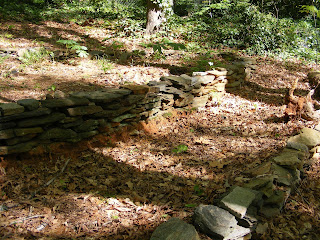The following photos are from an ongoing project, which was begun in 2002 and proceeds when time and money allow. Or when I can pick up some more rocks during field trips, roadcut stops, etc.. [I hate having to pay for rocks, but I have to sometimes to get the variety that I want. I don't have a ready source where I can dig my own river gravels, volcanic cinders, gray slate, etc..]
Some family members would probably call these "unfinished projects", I would prefer to call them "in-progress".
The rocks and other materials come from a wide variety of sources. The flat stones adjacent to the driveway and the walkway in the first photo are from rock walls at the "old homeplace" (that was torn down a few years ago). Other flat stones from those rocks walls "live on" in rock walls in the current back yard.
The bricks are from three different sources. The first batch is composed of old hand-made bricks from the late 1850s, from the two-story brick home that my great, great-grandfather, purchased after the Civil War. The home itself burned in the mid-1960s, but scattered bricks were to be found until the site was developed into a strip mall and theater complex.
I made a few trips over across the Chattahoochee River to gather a few dozen bricks at a time in the 1970s through the early 1990s. [My great, great grandfather was reputed to have buried gold coins in jars as he didn't trust banks. One story was that when he suffered a stroke in 1888, prior to his death, he wasn't able to tell the family where he buried the jars. I didn't find any of them, myself. I wonder how many gold coins are buried under those asphalt parking lots?]
The next batch of bricks are from a former family brick company in the center of our town, presumably from the 1920s or so. Despite being of fair to poor quality, several buildings were built using these bricks and due to renewal projects, several of these buildings have been torn down, again providing a source for a few dozen bricks.
More recent additions include these broken slabs of "Baltic Brown Granite", collected from around a dumpster. In the storage area that a friend uses, a small granite countertop company had closed and had dumped dozens of chunks of waste rock around the dumpster, so being a kind, benevolent Geologist, I gave these chunks of porphyritic, orbicular granite a home.
The bricks used in edging this project were from a brick walkway at the "old homeplace".
Current photo of the "Baltic Brown project" shows soil that has washed in due to recent heavy rains. Will have to figure out how to resolve this. Also, in the second photo, you can see how moss has colonized the interstices between the flat stones. In addition, the moss prefers the old, handmade 1850's bricks versus the newer ones.
This photo shows some of the rock walls in the back yard, the one on the left encircles a wildflower garden. Most of these flat stones were retrieved from the old homeplace.

I picked up this irregular slab of granite from a granite-finishing place near Elberton, GA. Some family members at first thought it looked like a headstone, but have gotten used to its presence.

Another rock wall encircling my Liriope bed, this happens to be under an old ornamental cherry tree and it "hosts" yellow morel mushrooms, suitable for cooking and enjoyment.

These thin sandstone slabs are among the few stones that I have purchased. I wanted to have a small flower bed in the "middle" of the yard and I didn't have enough of the other flat stones.

There are other small rock walls encircling other flower beds, etc. and I am always on the lookout for sources of flat stones, large (20 - 30 lbs. or so) and small.
If we have to move to a smaller home, I am willing to leave most of this behind, though I will ask the next owners if they plan to keep them. If they answer that they plan to get rid of any or all of it, I will find a way to move it somewhere else.
I hope that I may have inspired some other Geologists to put their "yard rocks" to good use. Though some of them are too big or ugly to be indoors, we can still show them the respect and affection that they deserve, after we removed them from their original homes.







